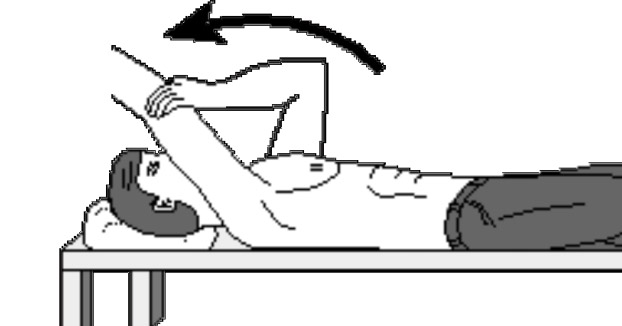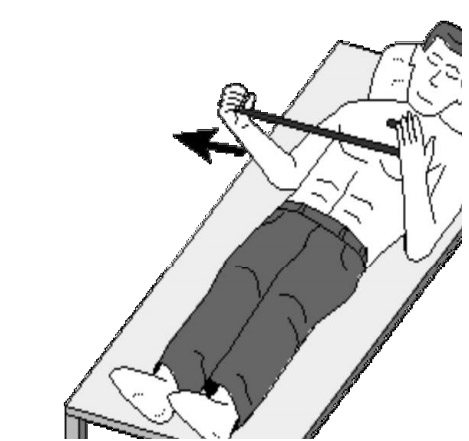Shoulder Fractures
Non-operative Clavicle Fracture
PHASE I: Protect clavicle (Injury to 2 weeks)
- Sling at all times
- No lifting with injured arm
- Motion: No shoulder ROM
- Elbow and forearm exercises, ball squeeze exercise
- Strengthening: No resistive exercises/activities
PHASE II: Advance ROM (2-6 weeks)
- Sling: for comfort
- Motion: Begin gentle PROM exercises followed by AAROM and AROM in all planes to pain tolerance
- Strengthening: Begin gentle Theraband resistive exercises at 4 weeks
PHASE III: Restore function (6-12 weeks)
- Sling: Discontinue sling at all times
- Motion: goal for full motion by week 12
- Strengthening: Progress to higher weights and sports specific training at week 10
- Return to sports 3-6 months from surgery
ORIF Clavicle
PHASE I: Protect fixation (1 to 2 weeks)
- Sling: for comfort
- Motion: Immediate Pendulum ROM exercises, No overhead motion
- Strengthening: No resistive exercises/actvities
PHASE II: Advance ROM (2-6 weeks)
- Sling: for comfort
- Motion: Immediate Pendulum ROM exercises, Begin gentle PROM above shoulder level, Begin AROM, AAROM in all planes to pain tolerance
- Strengthening: Begin gentle theraband resistive exercises
PHASE III: Restore function (6-12 weeks)
- Sling: Discontinue sling
- Motion: full motion by week 12
- Strengthening: Progress to higher weights and sports specific training at week 10
- Return to sports 3-6 months from surgery
ORIF Proximal Humerus Fracture
Outpatient Physiotherapy PHASE 1: (Weeks 2-4)
ROM
- Cervical, elbow and wrist ROM
- Pendulum exercises
- Instruct Home Exercise Program
Strengthening
- No cuff strengthening
- Begin and instruct in program of postural correction
- May begin scapular retraction and depression
- Grip strengthening
Sling
- Arm in sling at all times except for exercises and bathing; includes sling at night (sleeping in recliner chair optimal); Discontinue sling between 2-4 weeks
Outpatient Physiotherapy PHASE 2: (Weeks 5-8)
ROM
- Begin self-assisted forward elevation to 90° and progress in 20° increments per week
- Use Pulleys
- Begin self-assisted ER with progressive return to full in 20° increments per week
- IR in scapular plane as tolerated (No IR behind back)
- No cross body adduction
- Grade I-II scapulothoracic and glenohumeral mobilizations
Strength
- No cuff strengthening
- Continue scapular retraction and depression
- Lower extremity aerobic conditioning
Other
- Modalities to decrease pain and inflammation
- Cryotherapy as necessary
Outpatient Physiotherapy PHASE 3: (Weeks 9-12)
ROM
- Progressive return to full forward elevation and external rotation
- May begin posterior capsular stretching program
- May begin IR behind back
- Grade III-IV glenohumeral and scapulothoracic mobilizations
- Begin anterior chest wall stretches (pectoralis minor)
Strength
- Instruct in home program and begin submaximal isometrics in flexion, abduction, IR, ER and extension
- Add progressive isotonics with low resistance, high repetitions as tolerated
- Emphasize anterior deltoid strength and scapular stabilization
- Emphasize upper trapezius, serratus anterior force couple rehabilitation to create stable scapular base
- Assess for and correct compensatory movement patterns
- UBE with low resistance
- Continue aerobic conditioning
Outpatient Physiotherapy PHASE 4: (> Week 12)
ROM
- Progressive return to full motion in all planes
- Emphasize posterior capsule stretching
- Maintenance home flexibility program
Strength
- Continue rotator cuff and scapular strengthening program
- Progressive increase in resistance as strength improves
- Continue UBE with progressive resistance as tolerated
- Recreation/vocation specific rehabilitation
- Maintenance aerobic conditioning home program
Proximal Humerus Fractures: Nonoperative Treatment
Outpatient Physiotherapy PHASE 1: (Weeks 2-4)
ROM
- Cervical, elbow and wrist ROM
- Pendulum exercises
- Instruct in home program
Strengthening
- No cuff strengthening
- Begin and instruct in program of postural correction
- May begin scapular retraction and depression
- Grip strengthening
Sling
- Arm in sling at all times except for exercises and bathing; Includes sling at night (sleeping in recliner chair optimal); Discontinue sling between 2-4 weeks
Outpatient Physiotherapy PHASE 2: (Weeks 5-8)
ROM
- Begin self-assisted forward elevation to 90° and progress in 20° increments per week
- May use pulleys
- Begin self-assisted ER with progressive return to full in 20° increments per week
- IR in scapular plane as tolerated (No IR behind back)
- No cross body adduction
- Grade I-II scapulothoracic and glenohumeral mobilizations
Strength
- No cuff strengthening
- Continue scapular retraction and depression
- Lower extremity aerobic conditioning
Other
- Modalities to decrease pain and inflammation
- Cryotherapy as necessary
Outpatient Physiotherapy PHASE 3: (Weeks 9-12)
ROM
- Progressive return to full forward elevation and external rotation
- May begin posterior capsular stretching program
- May begin IR behind back
- Grade III-IV glenohumeral and scapulothoracic mobilizations
- Begin anterior chest wall stretches (pectoralis minor)
Strength
- Instruct in home program and begin submaximal isometrics in flexion, abduction, IR, ER and extension
- Add progressive isotonics with low resistance, high repetitions as tolerated
- Emphasize anterior deltoid strength and scapular stabilization
- Emphasize upper trapezius, serratus anterior force couple rehabilitation to create stable scapular base
- Assess for and correct compensatory movement patterns
- UBE with low resistance
- Continue aerobic conditioning
Outpatient Physiotherapy PHASE 4: (> Week 12)
ROM
- Progressive return to full motion in all planes
- Emphasize posterior capsule stretching
- Maintenance home flexibility program
Strength
- Continue rotator cuff and scapular strengthening program
- Progressive increase in resistance as strength improves
- Continue UBE with progressive resistance as tolerated
- Recreation/vocation specific rehabilitation
- Maintenance aerobic conditioning home program
Humeral Shaft Fracture (ORIF)
PHASE I: Protected ROM (6 weeks)
- Keep dressing in place, you may shower directly over clear plastic.
- Sutures are all underneath the skin and will dissolve on their own.
- Ice or cold flow systems encouraged for the first week at a minimum: should be used 3-4 times per day.
- Sling should be in place when not performing exercises.
- May start active scapular mobility exercises– Must keep the shoulder musculature relaxed.
- Initiate exercise program 3 times per day during first two weeks:
- Immediate elbow, forearm and hand range of motion out of sling Pendulum exercises
- Passive scapular plane elevation as tolerated (see picture below)
- Passive external rotation of the shoulder to tolerance (see picture below)
- 3 to 5 times each day you should perform assisted overhead reaching and external rotation (outward turning) exercises with the operative arm. Both exercises should be done with the non-operative arm used as the "therapist arm" while the operative arm remains relaxed. Ten of each exercise should be done three to five times each day.

Overhead reach is helping to lift your stiff arm up as high as it will go. To stretch your overhead reach, lie flat on your back, relax, and grasp the wrist of the tight shoulder with your opposite hand. Using the power in your opposite arm, bring the stiff arm up as far as it is comfortable. Start holding it for ten seconds and then work up to where you can hold it for a count of 30. Breathe slowly and deeply while the arm is moved. Repeat this stretch ten times, trying to help the arm up a little higher each time.
External rotation is turning the arm out to the side while your elbow stays close to your body. External rotation is best stretched while you are lying on your back. Hold a cane, yardstick, broom handle, or dowel in both hands. Bend both elbows to a right angle. Use steady, gentle force from your normal arm to rotate the hand of the stiff shoulder out away from your body. Continue the rotation as far as it will go comfortably, holding it there for a count of 10. Repeat this exercise ten times.

PHASE II: Progressive ROM (6 to 12 weeks)
- May discontinue sling.
- Lifting restriction of 5 pounds should be reinforced with patient.
- Start AAROM and AROM – includes pulleys, wand and supine gravity assisted exercises. Emphasize all motions including IR behind the back at 10-12 weeks.
- Isolate and strengthen scapular stabilizers.
- Progress PROM and terminal capsular stretching of the shoulder as needed.
- Avoid AROM in positions of subacromial impingement.
- May start gentle rotator cuff strengthening at 8 weeks
PHASE III: Progressive ROM (> 12 weeks)
- Discontinue formal lifting restrictions.
- Advance rotator cuff and shoulder strengthening (Theraband, dumbbells, Hughston’s exercises, etc). Include home cuff strengthening program. Continue to emphasize scapular stabilizers.
- Equate active and passive range of motion. Encourage scapulohumeral mechanics during active shoulder motion.
- Simulate work/recreational activities as rotator cuff strength and endurance improve.
Lower Trapezius Tendon Transfer to Greater Tuberosity
PHASE I: Protected ROM (8 weeks)
- Patients may shower immediately over clear plastic, waterproof dressing
- Sutures are all underneath the skin and will dissolve on their own.
- Ice or cold flow systems encouraged for the first week at a minimum: should be used 3-4 times per day.
- Gunslinger brace should be in place when not performing exercises.
- From 2 weeks until 6 weeks, perform overhead reach (see below)

- Overhead reach is helping to lift your stiff arm up as high as it will go. To stretch your overhead reach, lie flat on your back, relax, and grasp the wrist of the tight shoulder with your opposite hand. Using the power in your opposite arm, bring the stiff arm up as far as it is comfortable. Start holding it for ten seconds and then work up to where you can hold it for a count of 30. Breathe slowly and deeply while the arm is moved. Repeat this stretch ten times, trying to help the arm up a little higher each time.
- May start active scapular mobility exercises at 6 weeks – Must keep the shoulder musculature relaxed.
- Avoid all active and active assistive exercises until cleared by the surgeon. This includes pulley exercises, wand and supine assisted exercises.
- Initiate exercise program 3 times per day:
- Immediate elbow, forearm and hand range of motion out of sling
- Passive external rotation of the shoulder to tolerance - instruct family member (start at 6 weeks)
- PROM into scapular plane elevation to 120 degrees (start at 6 weeks)
PHASE II: Progressive ROM (6 to 12 weeks)
- May discontinue brace at 6 weeks.
- Lifting restriction of 5 pounds should be reinforced with patient.
- Start AAROM and AROM – includes pulleys, wand and supine gravity assisted exercises. Emphasize all motions except IR behind the back until 3 months.
- Isolate and strengthen scapular stabilizers.
- Progress PROM and capsular stretching of the shoulder as needed – elevation and external rotation as tolerated
- Avoid resisted training or strengthening. Avoid AROM in positions of subacromial impingement.
PHASE III: (> 12 weeks)
- Discontinue formal lifting restrictions.
- Start progressive rotator cuff and shoulder strengthening at 3 months – isometrics initially
- Initiate isotonic strengthening at 4 months (Theraband, dumbbells, Hughston’s exercises, etc). Include home cuff strengthening program. Continue to emphasize scapular stabilizers.
- Equate active and passive range of motion. Encourage scapulohumeral mechanics during active shoulder motion
- Simulate work/recreational activities as rotator cuff strength and endurance improve.
Supine Passive ROM
Three to 5 times each day you should perform supine passive forward elevation and external rotation (outward turning) exercises with the operative arm. Both exercises should be done with the non-operative arm used as the "therapist arm" while the operative arm remains completely relaxed. Ten of each exercise should be done three to five times each day.

Overhead reach is helping to lift your stiff arm up as high as it will go. To stretch your overhead reach, lie flat on your back, relax, and grasp the wrist of the tight shoulder with your opposite hand. Using the power in your opposite arm, bring the stiff arm up as far as it is comfortable. Start holding it for ten seconds and then work up to where you can hold it for a count of 30. Breathe slowly and deeply while the arm is moved. Repeat this stretch ten times, trying to help the arm up a little higher each time.
External rotation is turning the arm out to the side while your elbow stays close to your body. External rotation is best stretched while you are lying on your back. Hold a cane, yardstick, broom handle, or dowel in both hands. Bend both elbows to a right angle. Use steady, gentle force from your normal arm to rotate the hand of the stiff shoulder out away from your body. Continue the rotation as far as it will go comfortably, holding it there for a count of 10. Repeat this exercise ten times.

ORIF mid-humerus
Coming soon
 You will need the Adobe Reader to view and print these documents.
You will need the Adobe Reader to view and print these documents.









